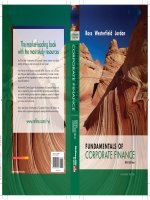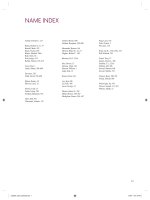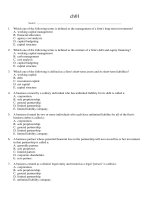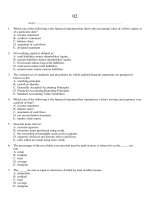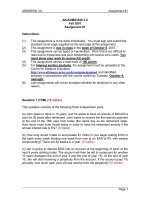assignment13 fundamentals of corporate finance, 4th edition brealey
Bạn đang xem bản rút gọn của tài liệu. Xem và tải ngay bản đầy đủ của tài liệu tại đây (33.12 KB, 4 trang )
AP/ADMS3530 3.0
Assignment #2
Winter 2011
Instructions:
______________________________________________________________________
(1)
This assignment is to be done individually. You must sign andsubmit the
standard cover page supplied as the last page of this assignment.
(2)
Before you start, please read the note “Writing Style Required for ADMS3530
Assignments” posted on the course web site. Please stick to the writing
guidelines suggested in the note.
(3)
This assignment is due in the class of the week of March 21, 2011.
(4)
For Internet section students, the assignment must be uploaded to the Centre
for Distance Education:
/>and identified precisely in accordance with the course outline by Tuesday,
March 22, 2011, midnight.
(5)
This assignment must be handwritten. Work that is too difficult to read due to
messiness and poor handwriting will receive zero credit. You must show your
work to receive full credit.
(6)
This assignment carries a total mark of 100 points.
(7)
Late assignments will not be accepted whether for technical or any other reason.
(8)
Decimal places: please keep at least 4 in your calculations and 2 in your final
answers.
______________________________________________________________________
Question 1- DCF Analysis (20 Marks)
Rigger Mortis Corp. is in the business of making whiteboard markers. They are
evaluating the potential of investing in some new equipment that will improve their
manufacturing process. The initial cost of the new machinery is $470,000 plus a onetime installation cost of $5,000. All ongoing fixed costs related to production is $93,500
per year and variable cost of production is $0.18 per marker produced. Sales estimates
for markers are 250,000 units per year over the next 5 years which is also the peak life
expectancy of the new machinery. You have signed an agreement with a 3rd party to
sell the machinery at 7.5% of the initial cost (excluding installation) at the end of the 5
years. The company’s required return on this project is 12% per year, their corporate
tax rate is 38% and the machinery falls into a 25% CCA class.
Based on the above information what should be the MINIMUM selling price per marker?
1
Question 2- NPV and Other Investment Criteria (20 Marks)
The Ace Manufacturing Company is considering the following investment proposal. The
initial investment is $100,000. It has an expected economic life of 10 years. The net
cash flow in the first year is expected to be $25,000 and annual net cash flow is
expected to grow at the rate of 10% per year. The cost of capital is 5%.
(a) What is the payback period?
(b) What is the discounted payback period?
(c) What is the net present value of the project?
(d) What is the profitability index of the project?
Question 3 – Scenario Analysis (20 Marks)
Based on the recent success of Ontario tennis star Milos Raonic, Nike Canada will
produce new state of the art tennis racket with a red maple leaf on the strings. Mike
expects to sell 10,000 rackets annually for the next 4 years. Each racket will retail at a
manufacturer’s suggested retail price (MSRP) of $475. Up-front depreciable costs
associated with this project are $800,000 and there will be no recovery of those costs at
the end of the four years. Variable costs are $350 per racket and fixed costs are
$300,000 per year. The project will require original net working capital of $450,000 that
will be fully recovered in year 4. The firm operates with a 9% discount rate and a 36%
marginal tax rate. The firm uses straight line depreciation over the life of the project.
(a) Calculate the NPV of this project.
(b) With the current economic conditions, Nike is worried about how sales of high-end
rackets will be affected. What will be the new NPV for this project if the sales price
decreases by 10%, unit sales per year decrease to 7,500 and the company’s up-front
costs increase to $950,000?
(c) Calculate the firm’s accounting breakeven point in sales dollars for the base case.
(d) Calculate the firm’s NPV breakeven points in sales dollars for the base case.
2
Question 4- Risk, Return and Diversification (20 Marks)
The following table presents the three possible states for stocks A and B returns.
State
Optimistic
Base
Pessimistic
Probability
0.2
0.5
0.3
Stock A Return
11%
6%
-2%
Stock B Return
19%
9%
-8%
(a) What are the expected returns and the standard deviations on Stocks A and B? (7
marks)
(b) What is the expected return and standard deviation of a portfolio with weights of
35% in Stock A and the remainder in Stock B? (7 marks)
(c) What is the correlation coefficient between stocks A and B? Interpret this result. (6
marks)
Question 5- CAPM and Portfolio (20 Marks)
You are provided with the following information:
Expected return on the market
13%
Standard deviation of the market
20%
return
Yield on Treasury bills
5.5%
Correlation coefficient between
Stock X and the market
0.60
Stock Y and the market
0.40
Standard deviation of Stock X return
64%
Standard deviation of Stock Y return
49%
(a) What is the expected return on Stock X?
(b) What is the expected return on Stock Y?
(c) Suppose you have $5,000 to invest in a portfolio made up of Stocks X and Y. How
will you allocate your funds between Stock X and Stock Y in order to achieve a portfolio
return of 15.67 percent?
(d) Calculate the beta of the portfolio in part (c). How risky is this portfolio? Explain.
(e) Your friend recommends that you buy Stock Z which has a beta of 2.76 and has an
expected return of 21.75 percent. Would you buy Stock Z? Explain.
3
Faculty of Liberal and Professional Studies
YORK UNIVERSITY
Toronto, Ontario, Canada
ADMS3530 3.0
Finance
Professor
Section
Assignment # 2
Due Date: Start of class, week of March 21, 2011
Personal Work Statement
I, the undersigned:
• warrant that the work submitted herein is my work and not the work of others
• acknowledge that I have read and understood the Senate Policy on Academic
Honesty
• acknowledge that it is a breach of the University Regulations to give and
receive unauthorized assistance on a graded piece of work
Name (typed or printed)
York Student #
Signature
4


